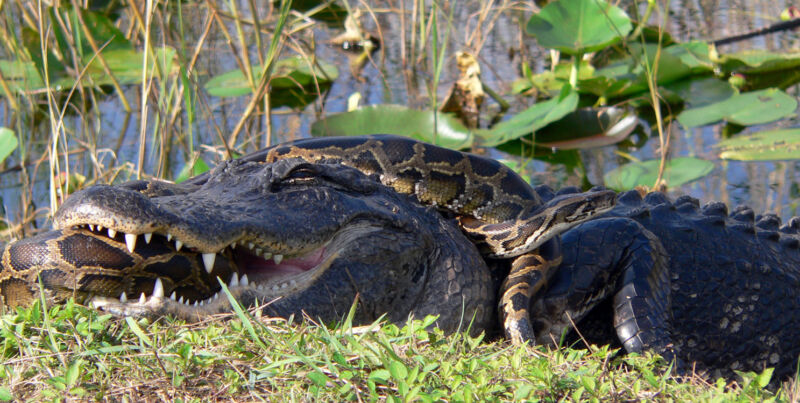
In addition to being home to men with questionable decision-making skills, Florida also seems to have some issues with bizarre animal behavior, whether it's freezing iguanas dropping from trees or alligators battling pythons in the Everglades. When it comes to those animals, however, Floridians can truly put the blame on non-natives. Neither pythons nor green iguanas made the Sunshine State their home until we brought them there as pets.
In fact, there are lots of problematic invasive species that have spread through the pet trade, from predatory fish that can drag themselves between bodies of water to a crayfish that clones itself to reproduce. Those high-profile cases lead to some obvious questions, like whether pets really are more likely to be invasive and, if so, why?
Two Swiss researchers, Jérôme Gippeta and Cleo Bertelsmeier have now attempted to answer these questions. And their conclusion is that yes, our pets are more likely to be problems.
We have bad taste
To answer the question of whether pets really are problematic, the researchers generated some basic statistics for different groups of animals (mammals, birds, reptiles, amphibians, and fish). These included estimates of the total number of species, as well as the number of those that are classified as invasive and the number that are part of the pet trade.
If pets were no more or less likely to be invasive, you'd expect to see the invasive ones occupy similar fractions of both the pet trade and the total number of species in that group. But that's not what we see in any of the groups. Invasive mammal species were present at five times the rate in the pet trade as they are in the wild around the globe. There was a similar result in birds; for amphibians, invasive species were eight times more common in the pet trade and about 10 times more common in fish.
Overall, invasive species were 7.4 times more likely to be kept as pets than you'd expect based on their frequency among vertebrate populations.
But cause and effect can be difficult to disentangle. Do we choose species that are more likely to be invasive as pets? Or have pets ended up with more opportunities to invade new environments because we transport them around the world?
Assaying ants
Gippeta and Bertelsmeier had a good way to answer this question—by using ants. Ants were pretty uncommon as pets prior to the past few decades. (I did have an ant farm as a kid, but they barely managed to invade the habitat we had for them before they all died, so it's not clear whether that species could contribute to the statistics.) As a result, ants have not had as many opportunities to invade new terrain via the pet trade. If ants invaded any habitats, they did so the old-fashioned way: by being invasive.
But it turns out that ants are completely unexceptional in terms of the trend the researchers saw in other species. The ants being sold as pets were about 6.6 times more likely to be invasive as you'd expect based on the frequency of invasive ant species. Of the 19 most invasive ant species, 13 of them were offered for sale as pets. Among all the species being sold, invasive species were offered for sale more often, as well.
Are there any features of the invasive species that make them more likely to show up in the pet trade? Gippeta and Bertelsmeier looked at five different properties common to invasive ants. Two of them—having multiple queens in a nest and being able to nest in a variety of sites—were no more likely to get the species used by the pet trade. But two others were. One was having a large range in their original habitat, and the second was occupying a variety of habitats within that range. Both of those would seemingly help the ants survive the questionable care they're likely to get once they reach their buyers.
There was one odd feature: invasive ant species tend to have smaller body sizes. But unsurprisingly, people tend to prefer species that they can see easily, so pets are more likely to have large body sizes, meaning there's an anti-correlation here.
For a lot of ecosystems, confirming that this is a problem is a bit like shutting the barn door after the horses have hit escape velocity and set a course for Pluto. But there are a lot of locations that are trying to get invasive species under control—often island nations or habitats like New Zealand and Hawaii. By identifying potential threats before they become problems, this information can help those places keep new threats from being established.
PNAS, 2021. DOI: 10.1073/pnas.2016337118 (About DOIs).
reader comments
79